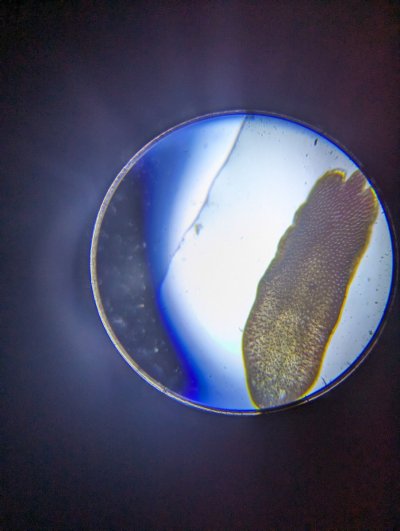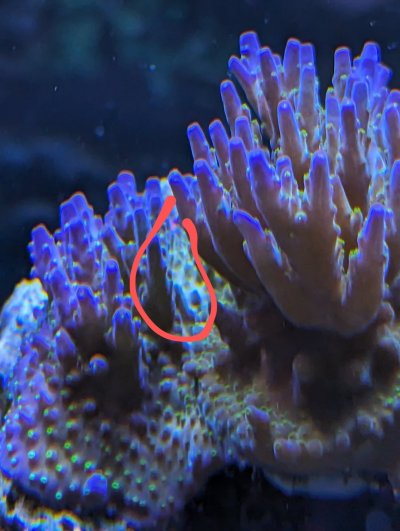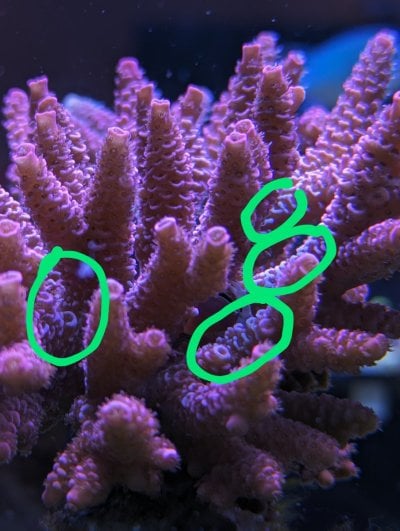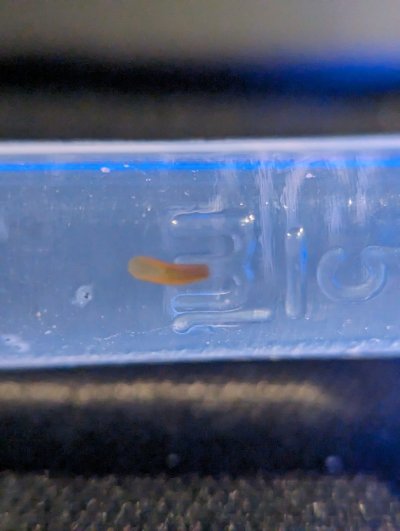Navigation
Install the app
How to install the app on iOS
Follow along with the video below to see how to install our site as a web app on your home screen.
Note: This feature may not be available in some browsers.
More options
You are using an out of date browser. It may not display this or other websites correctly.
You should upgrade or use an alternative browser.
You should upgrade or use an alternative browser.
Hi, welcome to Reef 2 Reef, i cant really tell what you are circling on the coral, is there small bite marks? can you also post a video on they move? this definitely looks like some kind of flatworm, and either aefw, or red planeria, which i dont really think so.
Hey, thanks!
Not directly bite marks but rather white spots..
Best video I can supply, I can't really see them on the coral but they do come off when I blast the corals with a turkey blaster
Not directly bite marks but rather white spots..
Best video I can supply, I can't really see them on the coral but they do come off when I blast the corals with a turkey blaster
I can’t answer your question, it I will happily bump your post up.

- Joined
- Dec 27, 2018
- Messages
- 3,827
- Reaction score
- 3,762
The white spots are bite marks. Get some Flatworm exit.
vetteguy53081
Well known Member and monster tank lover
View Badges
Partner Member 2024
Excellence Award
Reef Tank 365
RGB
Article Contributor
Tampa Bay Reef Keepers
West Palm Beach Reefer
Hospitality Award
Ocala Reef Club Member
305 Reef Club
Wisco Reefers
Midwest Reefer
Fish Medic
MAC of SW Florida
Rock Pool Reef Keepers
R2R Secret Santa 2023
My Tank Thread
My Aquarium Showcase
These are polyclad flatworms and while they are not harmful as red planaria, they in numbers can smother bases of coral and block the needed light for production of zooxanthellae which is their energy source.
Removal can be accomplished by siphoning them with a 3/8" tubing into a nylon stocking and discard
OR
Add a wrasse such as Yellow coris, 6 line, lunare or malanurus OR even a springieri damsel which will eat them
With the number you have, for the next 2 weeks you will have to look for eggs and scrape off as there is likely some and would be future acoels. Eggs are really tiny
These are polyclad flatworms and while they are not harmful as red planaria, they in numbers can smother bases of coral and block the needed light for production of zooxanthellae which is their energy source.
Removal can be accomplished by siphoning them with a 3/8" tubing into a nylon stocking and discard
OR
Add a wrasse such as Yellow coris, 6 line, lunare or malanurus OR even a springieri damsel which will eat them
With the number you have, for the next 2 weeks you will have to look for eggs and scrape off as there is likely some and would be future acoels. Eggs are really tiny

I actually do have a 6 line wrasse (who did a very good job at eating tubellaria back when I had an outbreak)
Manual removal is pretty much impossible on a larger scale as i can't really see them with the naked eye at all, I have to work with a turkey baster and hope to hit some if i want to get a specimen to look at. I'm just fairly worried about my acropora :s
And aefw are a species of polycladida, arent they?
Even now with the light being out for a couple of hours i can't spot any flatworms, that is until i get the baster and blast.
When you turkey bast, if they are floating around, the 6 line should pick them out of the water column, you could also get a springeri damsel, those also might eat them
When I turkey bast my 6 line goes into hiding for the next 30 minutes, lol. He's a bit of a scaredy.When you turkey bast, if they are floating around, the 6 line should pick them out of the water column, you could also get a springeri damsel, those also might eat them
I honestly don't want that damsel, I've heard many reports that they can be a tad mean, especially against other blue coloured fish which is like half my stock
you could also do a mel, but how big is your tank? i have a springeri and it is fine, but i have heard that they can be meaner, but not like normal damselsWhen I turkey bast my 6 line goes into hiding for the next 30 minutes, lol. He's a bit of a scaredy.
I honestly don't want that damsel, I've heard many reports that they can be a tad mean, especially against other blue coloured fish which is like half my stock
vetteguy53081
Well known Member and monster tank lover
View Badges
Partner Member 2024
Excellence Award
Reef Tank 365
RGB
Article Contributor
Tampa Bay Reef Keepers
West Palm Beach Reefer
Hospitality Award
Ocala Reef Club Member
305 Reef Club
Wisco Reefers
Midwest Reefer
Fish Medic
MAC of SW Florida
Rock Pool Reef Keepers
R2R Secret Santa 2023
My Tank Thread
My Aquarium Showcase
They are a type polyclad and its hit and miss with fish consuming them. Blue velvet nudibranch consumes them well if you can find one.I actually do have a 6 line wrasse (who did a very good job at eating tubellaria back when I had an outbreak)
Manual removal is pretty much impossible on a larger scale as i can't really see them with the naked eye at all, I have to work with a turkey baster and hope to hit some if i want to get a specimen to look at. I'm just fairly worried about my acropora :s
And aefw are a species of polycladida, arent they?
Even now with the light being out for a couple of hours i can't spot any flatworms, that is until i get the baster and blast.
As a last resort- Salifert flatworm exit but you still need to siphon daily to remove dead ones which can release toxins
Similar threads
- Replies
- 2
- Views
- 76
- Replies
- 7
- Views
- 228





















